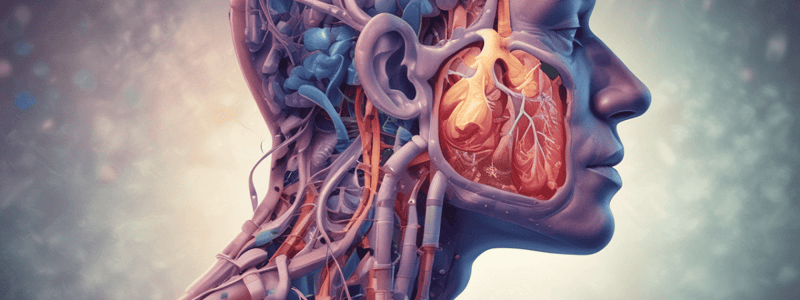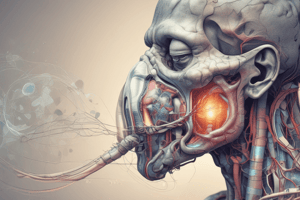Podcast
Questions and Answers
What is a common cause of Respiratory Center Depression?
What is a common cause of Respiratory Center Depression?
- Tracheal stenosis
- Drug overdose (correct)
- Pneumonia
- Asthma/COPD exacerbation
Non-Invasive Ventilation (NIV) is always used as a first-line treatment for Acute Respiratory Failure.
Non-Invasive Ventilation (NIV) is always used as a first-line treatment for Acute Respiratory Failure.
False (B)
What is the normal range for Respiratory Rate (RR) in ventilator settings?
What is the normal range for Respiratory Rate (RR) in ventilator settings?
12-20 breaths per minute
Hypoxemic Respiratory Failure is characterized by a PaO2 of less than ______________ mmHg.
Hypoxemic Respiratory Failure is characterized by a PaO2 of less than ______________ mmHg.
What is a common complication of Acute Respiratory Failure?
What is a common complication of Acute Respiratory Failure?
ARDS is always caused by a bacterial infection.
ARDS is always caused by a bacterial infection.
What is the definition of Acute Respiratory Distress Syndrome (ARDS)?
What is the definition of Acute Respiratory Distress Syndrome (ARDS)?
Match the following oxygenation strategies with their descriptions:
Match the following oxygenation strategies with their descriptions:
The optimal Tidal Volume (VT) in ventilator settings is typically ______________ mL/kg ideal body weight.
The optimal Tidal Volume (VT) in ventilator settings is typically ______________ mL/kg ideal body weight.
What is the primary goal of oxygen therapy in Acute Respiratory Failure?
What is the primary goal of oxygen therapy in Acute Respiratory Failure?
What is the primary cause of community-acquired pneumonia (CAP)?
What is the primary cause of community-acquired pneumonia (CAP)?
Ventilator-associated pneumonia (VAP) is always caused by Gram-negative bacteria.
Ventilator-associated pneumonia (VAP) is always caused by Gram-negative bacteria.
What is the mortality rate of hospital-acquired pneumonia (HAP)?
What is the mortality rate of hospital-acquired pneumonia (HAP)?
Acute Respiratory Distress Syndrome (ARDS) is characterized by bilateral infiltrates on chest ______________.
Acute Respiratory Distress Syndrome (ARDS) is characterized by bilateral infiltrates on chest ______________.
What is the primary goal of empiric therapy in respiratory infections?
What is the primary goal of empiric therapy in respiratory infections?
De-escalation of antibiotics is always based on culture results and clinical response.
De-escalation of antibiotics is always based on culture results and clinical response.
What is the primary concern with antibiotic resistance in respiratory infections?
What is the primary concern with antibiotic resistance in respiratory infections?
Pneumonia is an inflammation of the ______________ tract.
Pneumonia is an inflammation of the ______________ tract.
Match the following types of pneumonia with their characteristics:
Match the following types of pneumonia with their characteristics:
Flashcards are hidden until you start studying
Study Notes
Acute Respiratory Failure
Etiology
- Respiratory Center Depression:
- Drug overdose
- Stroke
- Trauma
- Infection (e.g., meningitis, encephalitis)
- Lung Parenchyma Disease:
- Pneumonia
- Pulmonary edema
- Pulmonary embolism
- Asthma/COPD exacerbation
- Airway Obstruction:
- Foreign body aspiration
- Laryngeal edema
- Tracheal stenosis
- Neuromuscular Disease:
- Guillain-Barré syndrome
- Myasthenia gravis
- Amyotrophic lateral sclerosis (ALS)
Oxygenation Strategies
- Oxygen Therapy:
- Low-flow oxygen (nasal cannula or mask)
- High-flow oxygen (non-rebreather mask or helmet)
- Non-Invasive Ventilation (NIV):
- Continuous Positive Airway Pressure (CPAP)
- Bilevel Positive Airway Pressure (BiPAP)
- Invasive Mechanical Ventilation:
- Volume-controlled ventilation
- Pressure-controlled ventilation
Ventilator Settings
- Mode:
- Assist-Control (AC) mode
- Synchronized Intermittent Mandatory Ventilation (SIMV) mode
- Tidal Volume (VT):
- 6-8 mL/kg ideal body weight
- Respiratory Rate (RR):
- 12-20 breaths per minute
- Positive End-Expiratory Pressure (PEEP):
- 5-15 cmH2O
- Fraction of Inspired Oxygen (FiO2):
- 0.21-1.0
Pathophysiology
- Hypoxemic Respiratory Failure:
- Inadequate oxygenation of the blood
- PaO2 < 60 mmHg
- Hypercapnic Respiratory Failure:
- Inadequate removal of carbon dioxide
- PaCO2 > 50 mmHg
- Respiratory Acidosis:
- pH < 7.35
Complications
- Respiratory Muscle Fatigue
- Pneumothorax
- Ventilator-Associated Pneumonia (VAP)
- Acute Respiratory Distress Syndrome (ARDS)
- Multi-Organ Dysfunction Syndrome (MODS)
Respiratory Infections
- Hospital-Acquired Pneumonia (HAP)
- Ventilator-Associated Pneumonia (VAP)
- Community-Acquired Pneumonia (CAP)
- Healthcare-Associated Pneumonia (HCAP)
ARDS
- Definition:
- Acute onset
- Bilateral infiltrates on chest radiograph
- PaO2/FiO2 ratio < 200 mmHg
- Stages:
- Mild ARDS: PaO2/FiO2 ratio 200-300 mmHg
- Moderate ARDS: PaO2/FiO2 ratio 100-200 mmHg
- Severe ARDS: PaO2/FiO2 ratio < 100 mmHg
Antibiotics
- Empiric Therapy:
- Broad-spectrum antibiotics (e.g., ceftriaxone, vancomycin)
- De-escalation to targeted therapy based on culture results
- Targeted Therapy:
- MRSA: vancomycin or linezolid
- Pseudomonas aeruginosa: anti-pseudomonal beta-lactam (e.g., piperacillin-tazobactam)
- Gram-negative bacteria: fluoroquinolone or aminoglycoside
Acute Respiratory Failure
Etiology
- Respiratory center depression can be caused by drug overdose, stroke, trauma, or infection
- Lung parenchyma disease can lead to ARF due to pneumonia, pulmonary edema, pulmonary embolism, or asthma/COPD exacerbation
- Airway obstruction can cause ARF due to foreign body aspiration, laryngeal edema, or tracheal stenosis
- Neuromuscular disease can cause ARF due to Guillain-Barré syndrome, myasthenia gravis, or amyotrophic lateral sclerosis (ALS)
Oxygenation Strategies
- Oxygen therapy can be administered via low-flow oxygen or high-flow oxygen
- Non-invasive ventilation can be used, including continuous positive airway pressure (CPAP) or bilevel positive airway pressure (BiPAP)
- Invasive mechanical ventilation can be used, including volume-controlled ventilation or pressure-controlled ventilation
Ventilator Settings
- Assist-control (AC) mode and synchronized intermittent mandatory ventilation (SIMV) mode are common modes used
- Tidal volume (VT) should be 6-8 mL/kg ideal body weight
- Respiratory rate (RR) should be 12-20 breaths per minute
- Positive end-expiratory pressure (PEEP) should be 5-15 cmH2O
- Fraction of inspired oxygen (FiO2) should be 0.21-1.0
Pathophysiology
- Hypoxemic respiratory failure occurs when PaO2 < 60 mmHg
- Hypercapnic respiratory failure occurs when PaCO2 > 50 mmHg
- Respiratory acidosis occurs when pH < 7.35
Complications
- Respiratory muscle fatigue, pneumothorax, ventilator-associated pneumonia (VAP), acute respiratory distress syndrome (ARDS), and multi-organ dysfunction syndrome (MODS) are possible complications
Respiratory Infections
- Hospital-acquired pneumonia (HAP), ventilator-associated pneumonia (VAP), community-acquired pneumonia (CAP), and healthcare-associated pneumonia (HCAP) are types of respiratory infections
ARDS
- ARDS is defined by acute onset, bilateral infiltrates on chest radiograph, and PaO2/FiO2 ratio < 200 mmHg
- Stages of ARDS include mild (PaO2/FiO2 ratio 200-300 mmHg), moderate (PaO2/FiO2 ratio 100-200 mmHg), and severe (PaO2/FiO2 ratio < 100 mmHg)
Antibiotics
- Empiric therapy involves using broad-spectrum antibiotics, which can be de-escalated to targeted therapy based on culture results
- Targeted therapy includes using vancomycin or linezolid for MRSA, anti-pseudomonal beta-lactam for Pseudomonas aeruginosa, and fluoroquinolone or aminoglycoside for Gram-negative bacteria
Respiratory Infections
- Pneumonia is an inflammation of the respiratory tract, often caused by bacterial or viral infections
- Community-acquired pneumonia (CAP) is acquired outside of healthcare settings
- Hospital-acquired pneumonia (HAP) is acquired in healthcare settings
- Ventilator-associated pneumonia (VAP) is acquired in patients on mechanical ventilation
- Other respiratory infections include bronchitis, bronchiolitis, sinusitis, and influenza
HAP/VAP/CAP
- Hospital-acquired pneumonia (HAP) has a high mortality rate of up to 50%
- HAP is often caused by multidrug-resistant bacteria such as MRSA and Pseudomonas
- Ventilator-associated pneumonia (VAP) has a high risk of mortality of up to 70%
- VAP is often caused by Gram-negative bacteria such as Pseudomonas and Acinetobacter
- Community-acquired pneumonia (CAP) is the most common cause of infectious disease-related hospitalization
- CAP is often caused by Streptococcus pneumoniae, Haemophilus influenzae, and viruses
Acute Respiratory Distress Syndrome (ARDS)
- ARDS is an acute inflammatory lung injury, characterized by bilateral infiltrates on chest X-ray, hypoxemia (PaO2/FiO2 < 200), and no evidence of heart failure or fluid overload
- ARDS can be caused by sepsis, pneumonia, trauma, aspiration, and pancreatitis
- The pathophysiology of ARDS involves increased permeability, inflammation, and damage to the alveolar-capillary membrane
- Treatment for ARDS includes supportive care, mechanical ventilation, and adjunctive therapies such as prone positioning and inhaled nitric oxide
Antibiotics
- Empiric therapy for respiratory infections involves broad-spectrum antibiotics, often including beta-lactams, macrolides, and fluoroquinolones
- De-escalation involves narrowing the antibiotic spectrum based on culture results and clinical response
- Antibiotic resistance is an emerging concern, particularly with Gram-negative bacteria such as carbapenem-resistant Enterobacteriaceae
Studying That Suits You
Use AI to generate personalized quizzes and flashcards to suit your learning preferences.



